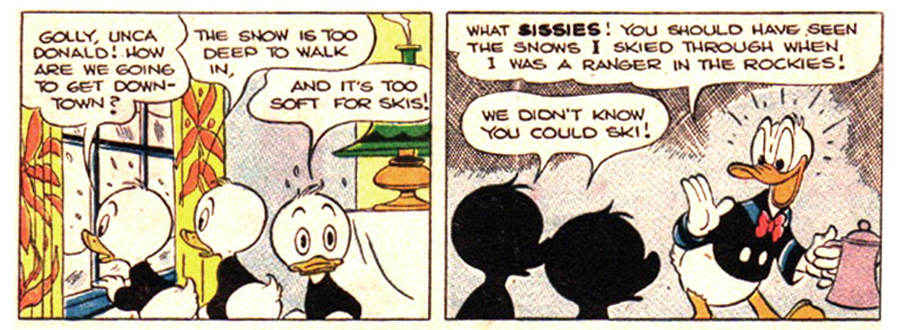JESSE HAMM’S CAROUSEL
Carousel 002: “Dealing” Broken Rules

Long, long ago, fitness maven Richard Simmons used to advertise a weight-loss program called “Deal-A-Meal.” The idea behind Deal-A-Meal was that users could allocate higher-calorie dishes to certain meals throughout the day. Users would receive a folder with calorie cards tucked into pockets on the left. As they ate their meals throughout the day, they would chart their caloric intake by transferring (“dealing”) the calorie cards into pockets on the right. In this way, they could easily track their calorie consumption. They could compensate for a big meal early in the day by eating fewer calories later, or they could save up for a big evening meal by eating fewer calories in the morning.
Drawing comics involves a similar method of “calorie management.” We’re often warned “never do this,” or “always be sure to do that,” but what’s feasible in cartooning is more complicated than a rigid set of do‘s or don’ts. Effective cartooning is a lot more like Deal-A-Meal. Many choices you make will have both benefits and drawbacks; your task isn’t to avoid all drawbacks, but to weigh the drawbacks against the benefits, and ensure that you come out ahead in the end. You may break rules in one panel, making choices that threaten to confuse the reader or lessen the panel’s impact, but if elsewhere you “deal” yourself fewer broken rules, the page as a whole can still function admirably.
Why would a cartoonist choose to break rules, hampering the clarity or impact of a given panel? There are several instances in which this option may be desirable. One is when you want to amplify the impact of a subsequent panel: A row of three dull panels will give more oomph to an explosive fourth panel. Another is the clarity/dynamism trade-off: You may need to sacrifice clarity in a panel to make it more dynamic, or sacrifice dynamism to make it more clear. A third reason is time: There are only so many hours in a day, and you may need to jettison useful details in Panel A so you’ll have the time you need to pack details of greater importance into Panel B.
All of this cost/benefit talk has been fairly abstract, so let’s consider some specific examples.
A tip I was often given when I started showing my portfolio around was to vary my camera angles. I was told that the camera angle in each panel should differ wildly from the angle in the preceding panel. So, a down-shot in Panel 1 should be followed by an up-shot in Panel 2; a close-up in Panel 3 should be followed by a long-shot in Panel 4; etc. This is an effective way to ward off monotony, especially if you’re working in an “action” genre, such as superheroes. However, I noticed that successful superhero artists don’t always follow this approach. Even some of the most celebrated superhero comics of all time—The Spirit, Watchmen, The Dark Knight Returns, Batman: Year One—include many sequences of eye-level, fixed-angle shots. Such shot progressions can be accused of lacking dynamism, but what they lose in dynamism, they gain in fluidity and momentum, like a musical note held for a few extra beats. And these artists didn’t simply park the camera in one place out of laziness or apathy. They were dealing out their “calorie cards” with calculating precision, knowing how much dynamism they could afford to lose, and where they could gain it back, with an abrupt up-shot or close-up.
The above example deals with dynamism; here is one pertaining to clarity. Another tip I was given, early on, was never to place a panel’s first speaking character on the right. This is sound advice. In comics that are read from left-to-right, having Character A speak on the right before Character B speaks on the left can confuse their apparent speaking order. It’s more clear to have Character A speak on the left before Character B speaks on the right. However, the geography of the scene sometimes poses problems for this approach. There are usually ways that you can remedy this, such as by dramatically shifting the camera angle, or repositioning the characters, or even rewriting the dialogue … but these remedies are often procrustean, and may hamper the flow of the scene even more than simply trusting the reader to realize that the first speaker is on the right. Below, for example, we see master cartoonist Carl Barks violate the first-speaker-on-the-left rule, to no ill effect:

In a perfect world, Donald would have stood on the left while delivering his line … but to achieve this, Barks would have had to swing the camera around 180 degrees, which would have hampered the visual smoothness of his panel transition. Instead, Barks “deals” himself an awkward speaking order—one losing hand sacrificed in a winning game. (It also helps greatly that he silhouetted the nephews’ heads in black, driving our attention immediately to Donald.)
The takeaway here is not that rules are meant to be broken at will, but that every rule comes with a sort of caloric value that you can afford to either spend or save, depending on the choices you make elsewhere in the narrative. If you break too many rules, the scene’s clarity and/or impact will suffer. But if you “deal” broken rules judiciously, taking compensatory measures elsewhere (such as the silhouetted heads in the above Barks panel), you can strike a balance that allows maximal flexibility within a context of effective storytelling.
See you next month!
Jesse Hamm’s Carousel appears the second Tuesday of each month here on Toucan!